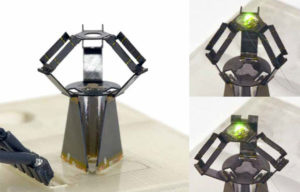
Harvard’s milliDelta Robot Is Tiny and Scary Fast
It may be small, but it’s one of the fastest moving robots we’ve ever seen

In terms of sheer speed and precision, delta robots are some of the most impressive to watch. They’re also some of the most useful, for the same reasons—you can see them doing pick-and-place tasks in factories of all kinds, far faster than humans can. The delta robots that we’re familiar with are mostly designed as human-replacement devices, but as it turns out, scaling them down makes them even more impressive. In Robert Wood’s Microrobotics Lab at Harvard, researcher Hayley McClintock has designed one of the tiniest delta robots ever. Called milliDelta, it may be small, but it’s one of the fastest moving and most precise robots we’ve ever seen.
Delta robots have two things about them that are particularly clever. The first one is that despite the highly dynamic nature of a delta robot, its motors are stationary. Most robot arms are made up of a series of rigid links and joints with motors in them, which is fine, except that it makes the arm itself very heavy. Moving all the motors to the base of the robot instead means that there’s way less mass that you have to move around, which is how delta robots can, in general, accelerate so rapidly and move so precisely. The second clever thing is that the end-effector of a delta robot—the bit where the arms come together—can stay parallel to the work surface (delta robots are a type of parallel robot). This makes delta robots ideal for pick-and-place operations, since they maintain the orientation of the thing you’re picking up.
Harvard’s delta robot takes all of this cleverness and shrinks it down into a fearsome little package. The 15 mm x 15 mm x 20 mm robot weighs just 430 milligrams, but it has a payload capacity of 1.3 grams. It can move around its 7 cubic millimeter workspace with a precision of about 5 micrometers. What’s really impressive, though, is the speed: It can reach velocities of 0.45 m/s, and accelerations of 215 m/s2, meaning that it can follow repeating patterns at a frequency of up to 75 Hz. Just watch:
Whoa.
MilliDelta is driven by piezoelectric actuators, which bend when you apply a voltage through them. The rest of the robot has been designed for monolithic fabrication; each piece is made of a sandwich of carbon fiber for the structural elements, Kapton film for the flextures, and some sheets of heat- and pressure-activated adhesive. Once assembled, the sandwiches were laser-micromachined into the right shapes and then assembled with the aid of a jig, although the researchers say that a pop-up approach to fabrication could be used to help automate the assembly process to make it easier and more consistent.

As far as what you could actually do with this scary little thing, there’s a bunch of possibilities. Obviously, small pick-and-place tasks, like placing components on circuit boards at high speeds, would benefit from milliDelta. So would microfactory applications, assembling small robots (like more milliDeltas, even). One less obvious but very compelling use-case for milliDelta is assisting humans in delicate microsurgery—the robot is fast enough that it can compensate for the natural tremors that surgeons experience, which could make things like eye surgery less risky.
Incidentally, the paper gave credit to the very first delta robot, and it’s an interesting story. The original delta robot was developed in 1985 to be used in—you guessed it—a chocolate factory. It was designed by Raymond Clavel, a professor at EPFL, and here’s part of the story:

One of the Robotics lab’s teaching assistants came back from a visit to a chocolate-maker with an idea: why not develop a robot that could place chocolate pralines in their packages automatically? The team was immediately interested. “The goal was to build a high-speed robot,” says Professor Clavel. “Our first idea was to use hydraulic motors because they’re more powerful, but we quickly realized we should take a different approach, since pralines only weigh about ten grams each. A robot with ultra-lightweight arms would be better.” The young Clavel was fascinated by the project, and he and his team constantly tested different designs. “I would come home from work and start tinkering with my wife’s knitting needles, looking for a structure that would work,” he recalls. The solution ultimately came to him: the robot would be composed of three articulated arms that would guide the travelling gripping device through three degrees of freedom in translation. As for the heavier motor components, they were to be placed not on the mobile part of the robot, but on its base. It was these design features that made the Delta so light and so fast.
Read more about the history of the delta robot here.

Leave a Reply